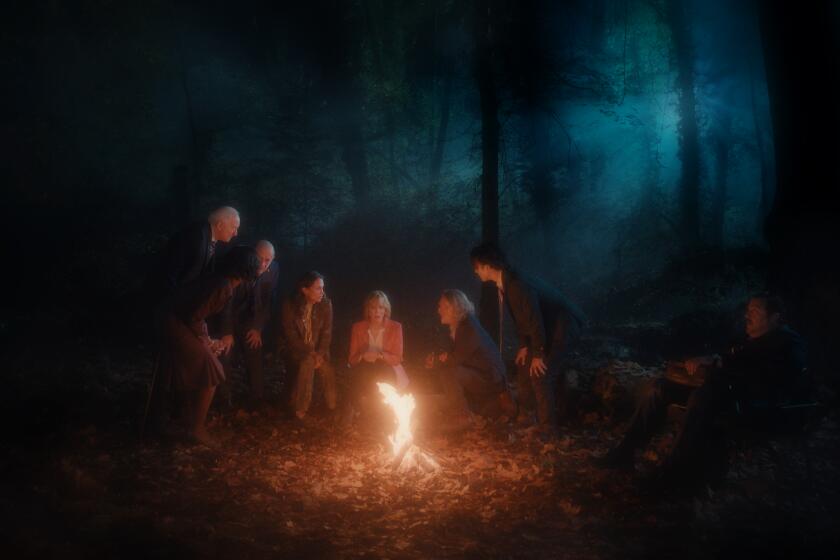New Hope for the Dead : THE SHARK-INFESTED CUSTARD, <i> By Charles Willeford (Underwood-Miller, 708 Westover Drive, Lancaster, Pa. 17601, (717) 285-2255: $20.95; 263 pp.)</i>
Scoff though you may, it is strictly for intellectual purposes that I am thinking of a magazine article in which Sharon Stone called herself “a sex babe.” Amen to that, brother, but I wish the redoubtable Ms. Stone had gone on to explain whether she has created categories for the rest of humanity. The category I am interested in at the moment could be called sex dolt.
For no other description will do justice to any of the four ladies’ men Charles Willeford created to be devoured in “The Shark-Infested Custard,” his blackly comic, posthumously published disemboweling of the sexual revolution. Willeford’s feckless chippy chasers have apparently never heard the old Miami riddle that inspired the title: “What is very sweet, bright yellow and extremely dangerous?” There is, you see, no time for contemplating metaphors when they are busy perfecting hedonism in a singles-only apartment house--working as little as possible so they can hang out, drink to excess and seduce nurses, teachers and stewardesses who are as insipid as they are.
In the pre-AIDS blissfulness of the early 1970s, these four swordsmen decide that a VD clinic is the best place to meet a like-minded member of the opposite sex. “They’ve all been treated recently, so they know there’s no danger of catching anything,” says Hank, the pharmaceutical salesman who is the quartet’s champion bedbug. And the toughest place to pick up a little action, they agree, is at a drive-in movie. A guy may show up at one alone, but a woman? Never. Naturally, the hormone-fueled Hank bets that he can beat the curse of the drive-in.
So in he goes at 7:41 p.m.--wearing a magenta suit, no less--and out he comes 31 minutes later with a drugged-up girl who looks as though she wandered away from her Brownie troop. She turns out to be 14. “A girl’s a girl,” Hank says, “and I had enough trouble snagging this one.” His intentions are casually callous.
And then they are blown away when the girl falls over dead.
It is a moment at once horrifying, perverse and hilarious. Now these happy-hour lotharios must think of something besides dancing the horizontal bop. They must figure out what to do with the girl’s body and how to handle the pusher she worked for. It matters not that one of them is an ex-cop nicknamed Fuzz-O who might logically be expected to go to the law. Better for all of them, they decide, to follow the path of convenience and amorality--even when it leads to murder. Their souls are deadened in the process, but you get the idea that they weren’t much in the soul department to start with.
Willeford liked his characters that way because they stirred his sense of the ridiculous and advanced his theory that contemporary society had turned into a joke it was too self-absorbed to understand. At his best, he wrote like James M. Cain with a funny bone, and he did it often enough to join the rare breed that can turn pulp fiction into literature. By his death in 1988, Willeford was the established master of portraying South Florida decadence, the big daddy in whose footsteps Carl Hiassen, James W. Hall and a host of lesser lights have followed. Is it any wonder, then, that a year or so earlier, he seemed a perfect candidate to write an episode of “Miami Vice”?
This was during my first full-time TV gig--I was one of the show’s seemingly endless parade of story editors--when my partners in crime and I were groping for a way to give “Vice” a jolt of adrenaline as it lurched toward its fourth season. Everything seemed to have been used already--babes, pastels, rock ‘n’ roll, white loafers without socks, black Testa Rossas and Frank Zappa as an actor. Then inspiration struck: We would go in a new direction with writers of the hard-boiled, hardcover variety. Like James Crumley. Yeah, and Roger L. Simon. And, of course, Charles Willeford.
We struck out with all of them, but Willeford managed to leave us laughing. He proposed an episode in which Don Johnson’s character--Sonny Crockett, an undercover cop in every way the censors would allow--came out of the closet. Don Johnson wasn’t big on sucker punches, and Willeford was savvy enough to know it. But worry about a star’s boundless ego and tender sensibilities? Hell, no. Charles Willeford had better things to do.
He specialized in the outrageous. The first time I picked up one of his books, “Miami Blues,” its opening words hit me like a surprise party: “Frederick J. Frenger Jr., a blithe psychopath from California . .” A blithe psychopath? I was hooked.
Go ahead, call me easy, but the rest of “Miami Blues” proved that my instincts were right. Willeford was indeed special, for he used this genre novel to create a homicide dick unlike any other. Not only did Sgt. Hoke Moseley of the Miami PD have his false teeth stolen by Freddy Frenger, but his wardrobe consisted of two wash-and-wear leisure suits, his new partner at work was a Cuban woman he didn’t understand, and his ex-wife had run off with a pinch-hitter for the Dodgers. He got his man, though, and Willeford got three more books out of the perpetually put-upon Hoke--”Sideswipe,” “The Way We Die Now” and, my favorite title, “New Hope for the Dead.”
There is, however, much more to his body of work than that, just as there was much more to the man than met the eye in his dust-jacket photos. They reveal Willeford’s passion for Hawaiian shirts and hats that covered his bald head. There always seemed to be a drink in his hand or a cigarette dangling from his lips. And hovering above his walrus mustache was a bulbous nose that was surely riddled with bursting capillaries. No wonder an admiring British writer described him as looking like “a gin-soaked old soldier.”
Willeford wasn’t posing. He fought in the Battle of the Bulge as an Army tank commander, and he went through enough hell there and in the rest of the European theater to win all manner of medals, including the one that proved he knew violence firsthand, the Purple Heart. But of the 20 years Willeford served in the military, the only ones he wrote about were the first ones, when he was a teen-aged cavalryman in the Philippines and all the world was new. He didn’t turn soft and gooey in the autobiographical “Something About a Soldier,” but if you read his recollection of fighting an old trooper who had taken an unsuspecting mail-order bride, you will realize how deep his feelings ran.
Somehow, though, Willeford dug even deeper emotionally in “I Was Looking for a Street,” and maybe that is why this memoir of being a juvenile hobo during the Depression is arguably his best book. It is poignant, evocative and utterly without self-pity. “I wasn’t alone,” Willeford wrote. “For the next few years there were thousands of boys my age riding freight trains to nowhere. But no one can ever tell me I didn’t have a happy childhood.”
And no one can tell me that, war aside, Willeford didn’t have a grand old time as a natural man. He taught college English, wrote poetry, dabbled in art, published 27 books of one kind or another and, yes, he would have a drink with you, too.
Five years after squeezing the last drop out of life and shucking this mortal coil at age 69, he is back among us with “The Shark-Infested Custard,” the novel that his wife campaigned to have published as his masterpiece. It falls somewhat short of that simply because it is disjointed, a condition that can be traced to the fact that parts of it were previously published separately in limited editions. But “Custard” is still a wonderful walk on the sleazy side of the street, every bit as gloriously pulpy as Willeford’s earlier triumphs, “Pick Up” and “Wild Women.”
The master’s touch can be found in Mr. Wright, a hit man who runs a corner grocery with his son when he isn’t plying his grim trade. If Mr. Wright isn’t strange enough for you, how about the vengeful woman who snares one of the sex dolts I mentioned earlier with her swampy aroma and the steel-wool hair growing under her arms? Her quarry, incidentally, is the same sex dolt who complains of feeling “a little logy” after downing two scotches and five cans of beer. Make no mistake, we are definitely in Willeford Country here.
Willeford himself is somewhere else, of course. But I hope he can get a drink there and find someone at the bar who won’t mind having his ear bent about what “The Shark-Infested Custard” proves: There really is new hope for the dead.
More to Read
The biggest entertainment stories
Get our big stories about Hollywood, film, television, music, arts, culture and more right in your inbox as soon as they publish.
You may occasionally receive promotional content from the Los Angeles Times.










